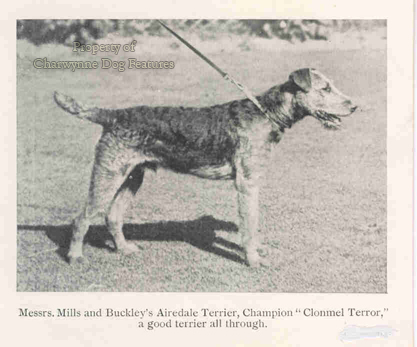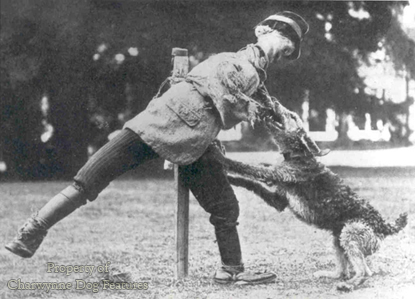413 Airedale-english griffon
THE ENGLISH GRIFFON--THE SPORTING AIREDALE
by David Hancock
 "The Airedale terrier cannot claim much in the way of ancient origin, as it was not until about 1853 that Wilfred Holmes crossed the local terriers...withthe otterhounds, in order to produce a larger and gamer type..." So wrote Frank Townend Barton, in his The Kennel Encyclopaedia of 1930. This cross-breeding has long been the perceived wisdom on the origin of this distinguished breed, but I am not convinced. Barton, who did not conduct his own research but relied on other writers' work, was repeating the words of Leighton and others from the early twentieth century. I suspect that Yorkshire sportsmen blended the blood of the old broken-coated black and tan working terrier with that of the northern breed of black and tan wire-haired hound, sometimes called the Lancashire Otterhound. The Otterhound, as we know it, did not emerge as a breed until after 1880. The classic Otterhound coat colours did not appear in the emergent breed of Airedale, and its coat texture does not feature in the breed, although early specimens were often goat-haired.
"The Airedale terrier cannot claim much in the way of ancient origin, as it was not until about 1853 that Wilfred Holmes crossed the local terriers...withthe otterhounds, in order to produce a larger and gamer type..." So wrote Frank Townend Barton, in his The Kennel Encyclopaedia of 1930. This cross-breeding has long been the perceived wisdom on the origin of this distinguished breed, but I am not convinced. Barton, who did not conduct his own research but relied on other writers' work, was repeating the words of Leighton and others from the early twentieth century. I suspect that Yorkshire sportsmen blended the blood of the old broken-coated black and tan working terrier with that of the northern breed of black and tan wire-haired hound, sometimes called the Lancashire Otterhound. The Otterhound, as we know it, did not emerge as a breed until after 1880. The classic Otterhound coat colours did not appear in the emergent breed of Airedale, and its coat texture does not feature in the breed, although early specimens were often goat-haired.
For me, it is an enormous pity that this breed of Airedale ever became dubbed a terrier. That word should be reserved for earth-dogs, dogs that go to ground. In France the Airedale would have been called a griffon, a rough-coated hunting dog, a hound if anything. This breed should not be regarded as a terrier and should not be judged by those more familiar with the breeds developed to go to ground. But above all, it should be regarded as a sporting dog, with the anatomy to allow it to function in the field. It is of course a remarkably versatile breed, able to undertake manifold tasks. My interest in them came from Colonel Richardson's use of them as service-dogs nearly one hundred years ago. This interest was increased when, as a young teenager working for my local vet, I went with him to visit Molly Harbut's world-famous 'Bengal' kennel of superlative Airedales, at Bathampton, near Bath.
Airedales were used extensively in the Great War as sentry-dogs, messengers and ambulance-dogs, emerging as the best all-round war dog breed. The Paris police elected to use them too. Colonel Richardson, who was Commandant of the British War Dog School then, recorded: "I have owned and trained at one time or other, nearly every kind of dog suitable for guarding work...but, as a result of all my work of years, it is my considered judgement, that for all-round watching and guarding work, the most reliable dog in size and character is the Airedale Terrier." In 1920, the Airedale was the most popular breed in the USA. Over 5,000 were registered here in each of the years 1924/25/26. Nowadays only a fifth of that number is registered each year, against 14,000 GSDs and 5,000 Rottweilers. In 1949, John Watson MacInnes FZS wrote a book entitled 'Guard Dogs', referred to Richardson's work, but made no mention at all of the Airedale, mainly recommending German breeds. That doesn't sound very honest to me.
More honestly, in 'Hounds and Dogs' of 1932, a volume of the Lonsdale Library, Capt. Banes Condy wrote: "No book dealing with Sporting Dogs would be complete without mention of the Airedale Terrier..." going on to state he had exported them to India to hunt jackal in pack "where his good nose, hardihood, lasting capabilities and strength make him invaluable." Banes Condy emphasized one point: "People, both breeders and novices, have somehow or another got it into their heads that an Airedale must be a rich black and tan in colour. This is erroneous..." In the world of kennel clubs all over the world today black and tan is the favoured breed colour; in the United States some breeders favour all-black and all-red Airedales, no doubt shocking the breed-purists.
As a sporting dog, the Airedale has long been valued, mainly overseas. In his 'Hunting Dogs' of 1909, the American sportsman-writer, Oliver Hartley recorded: "I have found out that the pure Airedale Terrier and the hound make the very best dogs for coon, lynx, mink, etc. Get a good Airedale and a good hound and you will have a pair of hounds hard to beat..." He went on to state that Airedales were 'great water dogs and very hard workers and easily trained to hunt any kind of game. They are full of grit and fear nothing...' He further sang the breed's praises 'in hunting and dispatching coyotes, coons, badger and bay-lynx (ie reddish-brown lynx), any one of which is capable of putting up a good fight. Also he is a hunter, retriever, trailer of coon, 'possum, bear, wildcat, mink, coyote, deer, lynx, fox or small game.' That is some tribute from a highly-experienced hunter, operating in difficult terrain.
In his 'The Coon Hunter's Handbook' of 1952, another American sportsman, Leon Whitney recommended the Airedale-hound cross, especially if a 'still-trailer' or silent tracker was required. A third American sporting dog expert, Carl P Wood, notes the value of the Airedale-hound cross, in his 'The Gun Digest Book of Sporting Dogs', in hunting the black bear, a dangerous occupation for any dog. For Airedale blood to be so highly rated by three such experienced hunters is noteworthy. In 1986, the Airedale Club of America staged the first of its annual hunting and working workshops. Using the Killdeer Plains wildlife arae in Ohio, a three day working trial was held for North American dogs. Day 1 was for upland bird hunting, Day 2 was for trailing and tracking fur and Day 3 was for retrieving. When are our comparable breed clubs going to perpetuate their breed's sporting instincts here? All over Britain there are under-exercised, unemployed but willing dogs wasting away.
An early fancier, a Mr. E Bairstow of Bradford, wrote around 1890: "In all my experience, I never came across any person who ever had an Airedale terrier over twelve months who would utter one word of disparagement against him...This breed owes its origin to the working or middle class inhabitants of Airedale and surrounding districts; take Bradford as the centre, and say about a 15 mile radius..." Do the good people who live in that catchment area now realise what their ancestors bequeathed to the sporting dog fraternity all over the world? Our precious sporting heritage slips away from us every year. Should not our Yorkshire-based breed devotees strive to celebrate such a local achievement? The towns of Rottweil and Leonberg would not miss such a chance!
In the United States, a number of our famous breeds of dog, long abandoned by sportsmen here, are still favoured in the hunting field. Bigger quarry is pursued using 90lb Airedales, twice the size of the showring breed here. The Southern/ROC kennel over there breeds the bigger specimens and, ignoring kennel club strictures, breeds blacks and reds too. This would horrify so many British Airedale breeders, who persist in a tightly closed gene pool whatever the outcome, a form of genetic madness. The dogs from the Southern/ROC kennel have excelled on bear and cougar. 
In Britain what one Airedale breeder eighty years ago proudly dubbed as 'burglar-proof' and 'holy terrors that will face sticks and bricks, can smell tramps a mile off, down intruders but love, honour and obey their owner', has become a breed defying its own ancestry. If you are seeking an open-coated, fluffy-legged, narrow-skulled, dewy-eyed pet with upright shoulders, no drive behind and restricted movement, then there are Airedale breeders here able to meet your requirements. If you want one willing to face a cougar, a strapping canine athlete displaying a determined eye, then look over the pond. But don't be upset when its coat colour doesn't match the Kennel Club stipulations, words for pedants not sportsmen!
A dog that can drive livestock, kill vermin, guard the farmstead and at a pinch pick up in the shooting field, has enormous value to the cash-strapped farmer. Yet here the breed of Airedale is ornamental. It is heartening therefore to learn of The Airedale Club of America's work in promoting the breed's hunting ability. For ten years now they have been running tests to trial the breed's all-round hunting skills: finding and flushing game, water-retrieving and 'coon tracking ability. It would be so worthwhile if the breed here could rediscover its sporting past in such a way. The worry would be that if an Airedale reached a high standard in field trials of some kind and proved itself as a superlative working dog with an admirable construction and immense breeding potential, it would only have value if it were black and tan or grizzle and tan. If some gifted breeder produced a solid red or black Airedale, with startling field capability, he would never be able to register such an asset to the breed. Colour prejudice is alive and kicking, sadly, kicking the pursuit of excellence and that is surely a severe handicap for any breed.